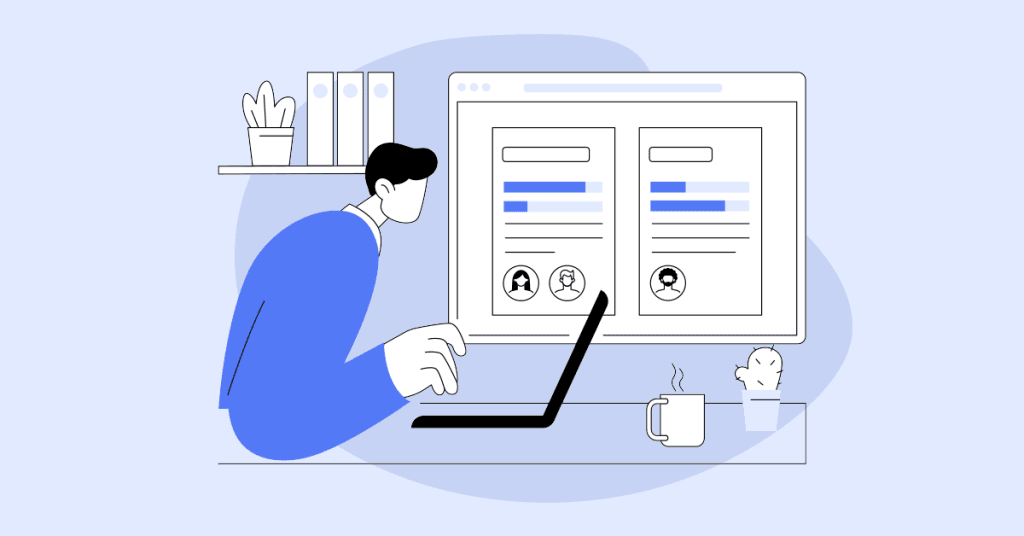Do you sometimes feel like your social media strategy is a case of throwing things at the wall and seeing what sticks?
On the one hand, you don’t want to be rapidly changing your approach all the time as it risks lacking the consistency needed to build loyalty and engagement… but at the same time, sometimes you need to switch things up a bit to see what does and doesn’t work with your audience.
The answer? A/B testing. Let’s take a closer look at how it can help you optimize your social media strategy.
What is A/B Testing?
A/B testing, sometimes called split testing, means comparing two versions of content to see which one performs better. It could involve changing elements such as images, headlines, or even call-to-action buttons and then sending out each version to different audience segments simultaneously.
You then compare metrics, such as engagement rates, click-through rates, and conversions, to see which version works best.
This helps to improve user experience by identifying what content users prefer and boosts conversion rates by optimizing the elements that motivate them to take action. This way, you can make data-driven decisions to create better and more engaging posts in the future.
Why A/B Testing Matters
Before we get into the details, let’s talk about why A/B testing is so useful.
Data-Driven Decisions
A/B testing can help take the guesswork out of what to post on your social media channels. Instead of relying on your intuition, you’ll have some concrete data that shows what your audience likes to see.
This is especially useful for demand generation strategies because it helps you understand which content your audience finds most engaging. This allows you to create focused, effective campaigns that drive interest and activity, resulting in a higher volume of qualified leads.
Improved Engagement
High engagement is the holy grail in social media marketing. By regularly testing and improving your posts with A/B testing, you can build your strategy around the content that your audience loves the most. And that means better engagement rates.

Free to use image sourced from Pixabay
Optimized Ad Spend
If you’re using paid social media advertising, you want to make sure you’re getting the most bang for your buck. By A/B testing your ads, you can allocate spending to the creative that is most effective.
Steps to Conduct A/B Testing for Social Media Posts
Ready to try A/B testing? Here’s your guide to getting started.
Define Your Goals
Before you get started, you’ll want to know what you’re setting out to achieve through your social media. Essentially – what does good look like for you?
This might be:
- Increase Engagement: Likes, comments, shares, and overall interactions.
- Boost CTR: Drive traffic to a website or landing page.
- Improve Conversions: Encourage specific actions like sign-ups, purchases, or downloads.
Identify the Elements to Test
Next, pick which elements of your social media posts you’re going to test. If you change several elements on each version, you won’t know which change had an effect. So, you ideally want to just make one significant change for each test.
Here are some different elements you might want to test:
- Visuals: Images, videos, infographics, and design.
- Copy: Headlines, body text, CTAs, and hashtags.
- Timing: The day of the week and the time-of-day posts are published.
- Ad Format: Single image, carousel, video, or stories.
- Audience Segmentation: Reached through separate ads.
Create Your Variations
Once you’ve decided which elements you’re going to test, create two (or more) different versions of your post. For example, if you want to test the effectiveness of your captions, you’d create 2 posts that are identical rather than having different captions.
If you’re testing posting time, you’ll use exactly the same creative across both posts, but you’ll schedule them for different times or days.

Image created by writer
Split Your Audience
Divide your audience randomly into two groups, you’ll expose each group to a different version of your post. Make sure you have a pretty equal split so that your results aren’t skewed by any other influences like demographics, gender, age, or location.
Monitor and Measure Performance
Once your posts are live with their respective audiences, track their performance using the metrics you decided on earlier.
Most social media platforms provide their own built-in analytics tools like Insights in the Meta Business Suite. Here, you can easily track and measure things like engagement, reach, views, and CTR’S.
Analyze the Results
Let your posts (or ads) run for long enough to get a reliable measure of interaction. This could be anything from a few hours to several days, depending on your audience size and the metrics you’re tracking.
Just make sure to measure each post for the same time period to make sure they both have equal exposure and your results are accurate. Once you’re happy you’ve got enough data, you can compare how your posts performed against each other.
Implement the Winning Version
Now you’ve got a winner, it’s time to give the star of the show the glory it deserves – implement the winning version as your primary post. Then, take what you have learned from the A/B test to guide your future content strategy and creatives.
You can also follow up with more A/B testing to refine your approach. For example, if you experimented with using more visual content versus your usual text-heavy posts, you could experiment with different image styles or CTA’s going forward to see if you can get even better results.

Image created by writer
Best Practices for Effective A/B Testing
While A/B testing itself is actually pretty straightforward, without the right preparation or a clear goal in mind, your results could be inconclusive or even useless. Let’s check off some best practices to follow:
Start with a Hypothesis
By this, I mean you should start your testing with a theory you want to prove, rather than blindly stabbing in the dark. For example, “using a video will get more engagement than a static image”. This gives your test a clear direction and purpose.
Test One Variable at a Time
If you change too many things in your post at once, you’ll have no idea which change made the difference. So, keep your posts identical, other than the single element you want to test.
Ensure Statistical Significance
A/B testing is no different from any other qualitative or quantitative testing you might do in that you need a decent sample size for your results to be meaningful. It’s no good showing your post to a handful of people and declaring a winner based on their reactions alone.
You need a big enough group to be confident that any differences you see between versions are real and not just random chance. If you’re not sure what sample size you need, you can use online calculators or statistical tools to give you a guide.
Use Consistent Metrics
You need to be comparing your posts like-for-like, so make sure you measure the same metrics across different tests. For example, measuring engagement on one test and then changing your approach to track CTR on the next one won’t give you a meaningful understanding of progress over time.
Whether it’s improving engagement, reach, or CTR, set a goal and stick with it.
Document Your Tests
Make sure to keep records for every test, noting down what you’re testing, the different versions, what you’re measuring, and what you find out. These notes will help you later on and improve how you do your future testing.

Free to use image sourced from Pixabay
Real-World Examples of A/B Testing on Social Media
Wondering how to use A/B testing in your social media strategy? Let’s look at some fictional examples to see how it works in real life.
Image vs. Video
A company specializing in VoIP systems wanted to improve engagement on its Facebook posts. So, they set out to test whether more people would engage with an image or a video.
They hypothesized that a video would achieve more engagement. They created two possible posts: one with a high-quality image of their CRM and VoIP integration features and the other with a small video clip demonstrating the benefits and functionality of the integration.
The video post received 35% more likes and a 50% higher number of comments compared to the post with images in it. Based on their result, they decided to make more use of video content within their social media plan.
CTA Phrasing
An e-commerce brand wants to increase its clickthrough rate on Facebook ads. They tested two variations of CTA phrases: “Shop Now” vs. “Discover More.” Their prior assumption was that “Shop Now” would lead to more direct sales.
Contrary to their prediction, “Discover More” performed 20% better in click-through, suggesting that the least direct CTA best ignited people’s curiosity and engagement. They adjusted future ad copy accordingly.
Posting Time
A lead generation company specializing in connecting businesses with B2B data providers wanted to know precisely when to schedule Twitter posts for optimal engagement. They tested posting at two different times: 9 AM vs. 6 PM. Their hypothesis was that evening posts would perform better since it is when most people surf social media after work.
The 6 PM posts were retweeted 40% more and liked 25% more than the 9 AM posts. This prompted the company to adjust their posting schedule, focusing more on evening times.

Image created by writer
Tools for A/B Testing on Social Media
Which tools you use for your A/B testing will depend on the platforms you want to test across and what metrics you’ll be tracking. Here are a few that you will find useful.
Facebook Ads Manager
Facebook is probably the easiest platform to run A/B testing on. Facebook Ads Manager is already set up to run A/B testing and basically does a lot of the work for you.
It gives you the option to test different creatives, copy, audiences, and placements. Plus, it gives you detailed analytics on how each post performs.
Google Analytics
Google Analytics might not be the first thing that springs to mind when you’re tracking social media campaigns, but it can be pretty useful.
By using UTM parameters, you can track which posts are driving traffic and conversions on your website. This is particularly useful if the goal of your test is to measure CTR or sales.
Instagram Insights
Similar to Facebook, Instagram ads tools include the functionality to run A/B testing, which is useful for splitting your audience. If you want to test the organic performance of your posts, Instagram Insights allows you to track the performance of individual posts using metrics like impressions, reach, or engagement.
X (Twitter) Analytics
X Analytics gives you detailed data on how your posts have performed, helping you track engagement metrics such as retweets, likes, and replies. It’s useful for A/B testing different tweet formats and posting times.
If you want to segment your audience for your test, then X Ads Manager provides this functionality.

Free to use image sourced from Pixabay
Common Pitfalls and How to Avoid Them
Let’s ensure your A/B testing journey is smooth sailing! To avoid common pitfalls and make sure you achieve your testing goals, here are a few things to watch out for.
Inadequate Sample Size
If your audience size is too small, it can lead to unreliable results. You want to make sure you have enough people in your sample to be statistically significant.
Short Testing Periods
You need to let your posts run for long enough to appear on your audience’s feeds and gather sufficient data.
A good rule is to allow a post or ad to run for at least two weeks before assessing performance. This allows for factors like time zone differences and how often your audience uses social media.
Ignoring External Factors
Make sure you take into account anything else going on that could impact the performance of your post before reaching a conclusion.
For example, if you run a test during a holiday or major world event that’s flooding everyone’s social media feed, your post might not get the attention it normally would.
Overcomplicating Tests
It can be tempting to think running multiple variables at the same time will give you answers quicker, but in reality, you’re likely to just end up with inconclusive results. Stick with testing one variable at a time to understand the impact of the changes you’ve made.
You can always run a series of tests to refine individual elements of your campaign one at a time.

Image created by writer
Not Learning from Results
If you only run an A/B test occasionally and then forget about it again, chances are you won’t see any long-term results from your efforts.
Regular testing should form part of your ongoing social media strategy, helping to refine and guide the sort of content you post and your posting schedule.
Testing Your Way to Social Media Success
With every A/B test you do, you can make a data-based decision on what works or doesn’t work and improve engagement, click-through rates, and conversions.
Keep in mind that successful A/B testing requires being consistent, patient, and open to trying new things. As you continue to experiment, learn more, and improve your methods, you’ll become better at making social media content that your audience loves and helps you reach your marketing goals.


